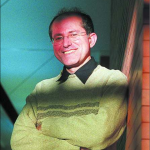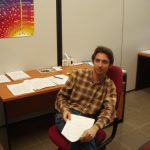| Email: | valle@ific.uv.es |
| Papers: | Inspire, ORCID, Google Scholar, Researcherid |
| Phone: | 963544459 |
| Office: | B6-7 |
| Institution: | CSIC |
Martin Hirsch
| Email: | mahirsch@ific.uv.es |
| Papers: | Inspire |
| Phone: | 963543513 |
| Office: | B6-4 |
| Institution: | CSIC |
Sergio Pastor Carpi
| Email: | sergio.pastor@ific.uv.es |
| Papers: | Inspire |
| Phone: | 963543510 |
| Office: | B5-5 |
| Institution: | CSIC |
Seminars of 2011
LSND and MiniBooNE anomalies as a signal of heavy sterile neutrinos
Seminars of 2010
Neutralino decaying dark matter
different R-parity violating couplings can yield an unstable
neutralino. We show that in this context astrophysical and
cosmological constraints on neutralino decaying dark matter forbid
bilinear R-parity breaking neutralino decays and lead to a class of
purely trilinear R-parity violating scenarios in which the
neutralino is stable on cosmological scales. We have found that
among the resulting models some of them become suitable to explain
the observed anomalies in cosmic-ray electron/positron fluxes.
Continue reading
Seminars of 2009
Oscillations of Mossbauer neutrinos
Mossbauer neutrinos can oscillate. After giving quantum mechanical arguments to support this statement, we will compute the oscillation probability of Mossbauer neutrinos, including localization and decoherence terms, in a
quantum mechanical wave packet model. We will then proceed to the calculation of the combined rate of Mossbauer neutrino emission, propagation and absorption in the framework of quantum field theory. This approach allows us to avoid making any a priori assumptions on the neutrino wave function, and it can easily describe the various effects that broaden the neutrino emission and absorption lines. Finally, we will also address the unrealistic, but theoretically extremely interesting, case of Mossbauer neutrinos affected only by natural line broadening and not by solid state effects.
Seminars of 2008
Ettore Majorana, its neutrino legacy and beyond: a genius at work
Seminars of 2007
The Epoch of Reionization
Seminars of 2006
SUSY Breaking on the Pillow - Gaugino Mediation and Gravitino Dark Matter in an SO(10) Orbifold GUT
Seminars of 2005
Supersymmetry breaking as the origin of flavor
Seminars of 2004
Invisible Higgs Boson Decays in Spontaneously Broken R-Parity
of the recent data on neutrino oscillations that indicate non-zero neutrino masses. We show that, despite the smallness of neutrino masses, the Higgs boson can decay mainly to the invisible Goldstone boson associated to the spontaneous breaking of lepton number.
The search for invisibly decaying Higgs bosons should be taken into account in the planning of future accelerators,
such as the Large Hadron Collider and the Next Linear Collider.
Seminars of 2003
Reconstruction of Supersymmetric High Scale Theories
Seminars of 2002
Neutrinos and Ultra-High Energy Cosmic Rays
More practical informations
Here you can find more practical information, especially useful if you plan on a long stay in the city.
Accomodations
- Col.legi Major Rector Peset, Plaça del Forn de Sant Nicolau 4. Tel.: 963166000. / Fax: +34 963 166 050
- Hotel Jardín Botánico ****, Dr. Peset Cervera 6. Tel.: 963154012.
- Hotel Bristol ***, Abadia de San Martín 3. Phone.: +34 963945100.
- Hotel Continental **, Correos 8. Tel.: 963535282.
- Hotel Valencia **, Convento San Francisco 7. Tel.: 963517460.
- Hotel Venecia **, Pza. Ayuntamiento (En Llop 5). Tel.: 963524267.
- Hotel Europa *, Ribera 4. Tel.: 963520000.
- Hostal Antigua Morellana, En Bou 2. Tel.: 963915773.
- Apartamentos Botanico 29, Botanico 29. Tel.: 963153702.
- Apartamentos Plaza Picasso, Góngora 6. Tel.: 963462849.
- Apartaments del Carme, Dr. Chiarri 6 and Marqués de Caro 8, Tel.: 647109793.
- Apartamentos Aparturist, Navellos 10, Tel.: 963910910.
- Apartamentos Living-Valencia, Plz. de la Merced 3. Tel.: 963941100.
- Hotel Trapemar **, Ctra de Lliria 116, 46100 Burjassot, Tel.: 963160550.
- Residencia Universitaria Campus Confort, Av. Primer de Maig 4. 46100 Burjassot, Tel.: 963160092.reservasvalencia@campuspatrimonial.es
- Residencia Universitaria Reuniver Burjassot, Obispo Muñoz 50. 46100 Burjassot, Tel.: 963635763.
Below we comment more on these options. For example, the closest accommodation options, walking distance from the IFIC-Paterna campus site are:
HOTEL TRAPEMAR These are two quiet and simple hotels are located in Burjassot, Trapemar and Los Silos, of the same chain. They are specially close to each other and to the univ. residence and the Burjassot-Paterna science campus of the U. of Valencia. They are well connected to the city center by the metro, tram and buses. Note that only Hotel Trapemar has a restaurant, not los Silos, but there are some bars and restaurants around, in addition to our own cantine or those in the Burjassot campus.
Residencia Campus Universitaria Campus Patrimonial Burjassot
Av.1ºde Mayo,4
46100 Burjassot (Valencia)
Tel: +34 963 160 092 / Fax: +34 963 631 183
This is a modern university accomodation, very close to the Burjassot-Paterna campus and very well communicated by public transport with Valencia. Rooms have a small kitchen and Wifi. The responsible person Cristina Mir Rubio.
Here is a local map showing the situation of Ver mapa más grande">RESA wrt IFIC and the surroundings.
The University of Valencia has Colegios Mayores, for example Col.legi Major Rector Peset is in the very center of Valencia, surrounded by historic locations, like the important Palau de la Generalitat or the nice Plaza de la Virgen. It is well communicated by public transport, tram or bus, with IFIC.
Some recommended hotels in Valencia havespecial fares for the University,In order to make a hotel room reservation in one of these, we suggest you to contact the travel agency Viajes el Corte Ingles (Valencia) via phone: +34 96 351 01 54 or or E-mail: csevalencia@viajeseci.es
Here is a list:
Downtown (price: around 80 euros with breakfast)
HOTEL ASTORIA **** (WiFi 24h-15euros)
HUSA REINA VICTORIA **** (WiFi 24h-15 euros, free Cable)
BEATRIZ REY DON JAIME **** (WiFi 24h-12 euros)
HUSA DIMAR **** (free WiFi)
HOTEL SILKEN PUERTA DE VALENCIA **** (free Cable)
HOTEL RENASA ***
North area (price: around 70 euros with breakfast)
EXPO *** (WiFi 24h-12 euros)
KRIS ABADIA *** (free Cable)
NH CENTER *** (WiFi 24h-17 euros)



